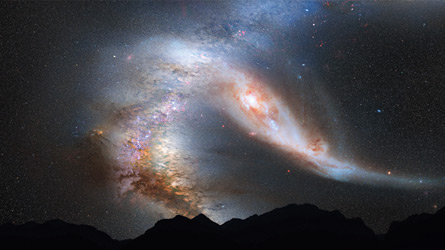Milky Way will bite the dust
Eventual collision with Andromeda to shake up the solar system
2012 SCIENCE NEWS TOP 25: 15
Assuming Earth is still here in 4 billion years, its skies will be spangled with the glowing shards of an epic cosmic collision. The Milky Way galaxy and its nearest neighbor, the enormous Andromeda galaxy, will plow right into one another (photo illustration, above, shows a view of Earth’s night sky during an early stage of the predicted galactic smashup). Earth’s solar system will be punted from its perch in the Milky Way’s Orion spur, drift for a while and probably end up orbiting much farther from the new galactic core, scientists from the Space Telescope Science Institute in Baltimore and colleagues reported in May (SN: 7/14/12, p. 10). Using the Hubble Space Telescope to measure the movement of stars in Andromeda, the team determined that the galaxy is heading straight for the Milky Way — at nearly 400,000 kilometers per hour. Though the galaxies are still 2.5 million light-years apart, gravitational attraction is pulling them together. The researchers speculate that another nearby galaxy — M33, the Triangulum — may get dragged into the pileup. Either way, the merger should be a spectacular sight for cosmic rubberneckers.
